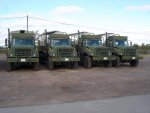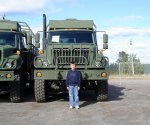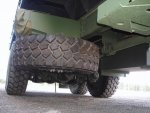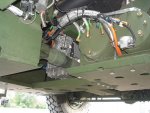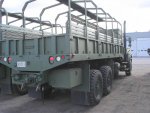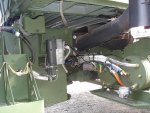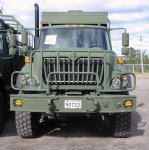GoldComet6
Member
- 642
- 2
- 18
- Location
- North GA
Interesting reading about MV events "Up North".
http://www.defenseindustrydaily.com...b-rfp-for-2300-medium-trucks-02391/#more-2391
Canada Issues CDN$ 1.2B RFP for 2,300 Medium Trucks
03-Dec-2008 12:24 EST
The FMTV Family
Just before Canada Day 2006, Canada’s minority Conservative Party government outlined a C$ 1.2 billion (USD $1 billion) RFP for new medium-sized logistics trucks and associated equipment. These trucks will become the new backbone of the Canadian Forces’ land transport capabilities, replacing the 1950s-era designs of its MLVW trucks (really, US M-35/M-36 designs with some modifications) built in the 1980s.
The Bombarider-built MLVWs are reaching the end of their service lives, and have limited up-armoring capacity which is crucial for survival in places like Afghanistan. This may explain why the Canadian forces in Afghanistan are relying on their HLVW heavy trucks instead, 10-ton capacity Steyr vehicles related to the smaller US FMTV medium truck family.
Under the new plan, the Canadian Forces will purchase up to 2,300 new medium trucks. What are the requirements? The configurations and numbers? Is this a welcome arrival that fills a critical gap? A mistake that will leave Canada out of step with shifting trends? Or a politically-driven move that falls into the “something, and hence better than nothing” category? Or all 3? DID has answers – and a recent update from Ottawa, which explains the lack of progress on this contract…
If You Could Read My Mind: Medium Truck Requirements
A competitive procurement process will select the contractor for the new truck fleet, with requests for proposals being released to industry for all elements of the project. The acquisition contracts will also have economic offsets – for every contract dollar awarded, the contractor will be expected to commit a corresponding dollar in economic activity in Canada.
“The procurement process will be fair, open, transparent and in line with this government’s Federal Accountability Act and Action Plan,” said Minister Fortier. The Department of National Defence will procure 2,300 vehicles, associated components, logistics and training support at a cost of approximately $1.1 billion. It is estimated that 20 years of contracted in-service support will cost an additional $100 million.
The project aims to procure approximately:
Go-Go Round: Contracts and Updates
Dec 1/08: The Ottawa Citizen’s David Pugliese reports on the medium truck project – and the news is not good:
“I received this from a frustrated individual on the inside with details on the truck program:
“DND will not release detailed specifications because they’re not sure where they will deploy next and don’t want to suffer any embarrassment if they ask for something that can perform well on Afghan roads but not elsewhere. They cannot specify what level of armour protection they want, how many armoured cabs they want, and what trade-offs for mobility they are willing to accept. (Even if they were to decide tomorrow, certifying the design through destructive testing at Aberdeen Proving Ground would take 2-3 years.)
Perhaps the most egregious thing is that they cling to old paradigms. They want a 4-tonne and 8-tonne capacity vehicle because that’s what they’ve always had. But they also say that they want NATO compatibility so that when cross-loading the loads don’t have to be re-packaged into smaller shipment. A loaded 20-foot ISO container is 16 tonnes (NATO standard) but they seem oblivious to this.
The project management office is wickedly understaffed…. The process is gummed up and no one seems able to cut through the illiteracy and risk-aversion, or the tendency to cling to tradition in a transformed world.”
Appendix A: It’s Too Late, He Wins – Issues and Analysis (July 1/06)
Some observers wonder if Canada might be about the repeat its past MLVW mistake by buying a design just as it nears the end of its life. The realities of modern missions around the world will include more frequent encounters with IED land mines, and a greater need for secure vehicles. This is just beginning to have significant effects on military vehicle design via elements like V-hulls et. al., and programs are in the pipe with a number of militaries to find new approaches.
A major buy at this juncture, say the critics, will lock Canada into a 1990s design just as others are moving forward, and trap Canada in that design for the next 20-30 years. Buy 100-200 hundred FMTV or MTVR medium trucks for US compatibility, use them in Afghanistan as an interim option, then wait for international developments and find a more modern and survivable bandwagon to jump on in 5 years or so.
A different view looks at the FMTV design, and sees future compatibility. Systems like the M142 HIMARS rocket launcher, and the next-generation MEADS air defense system, are based on FMTV trucks. While the FMTV design may or may not be optimal in 10 years, goes this argument, a small military like Canada’s needs maximum compatibility, and both HIMARS and MEADS are likely to be future necessities for a Canadian Forces that lacks both effective long-range punch and a viable air defense system for its forces (ADATS doesn’t qualify).
A third argument says that these previous arguments are somewhat beside the point. Canada has a minority conservative government that values the Cnaadian Forces and is willing to invest in them. Minority governments are unstable, and given past patterns there’s no guarantee that a Canadian government five years from now will still be interested in the Canadian Forces’ needs. While recapitalization based on military timing would be optimal, the reality is that political timing must be the dominant factor – and that political timing is now, for better or worse.
DID’s readers can decide for themselves which of these arguments holds more currency.
http://www.defenseindustrydaily.com...b-rfp-for-2300-medium-trucks-02391/#more-2391
Canada Issues CDN$ 1.2B RFP for 2,300 Medium Trucks
03-Dec-2008 12:24 EST
The FMTV Family
Just before Canada Day 2006, Canada’s minority Conservative Party government outlined a C$ 1.2 billion (USD $1 billion) RFP for new medium-sized logistics trucks and associated equipment. These trucks will become the new backbone of the Canadian Forces’ land transport capabilities, replacing the 1950s-era designs of its MLVW trucks (really, US M-35/M-36 designs with some modifications) built in the 1980s.
The Bombarider-built MLVWs are reaching the end of their service lives, and have limited up-armoring capacity which is crucial for survival in places like Afghanistan. This may explain why the Canadian forces in Afghanistan are relying on their HLVW heavy trucks instead, 10-ton capacity Steyr vehicles related to the smaller US FMTV medium truck family.
Under the new plan, the Canadian Forces will purchase up to 2,300 new medium trucks. What are the requirements? The configurations and numbers? Is this a welcome arrival that fills a critical gap? A mistake that will leave Canada out of step with shifting trends? Or a politically-driven move that falls into the “something, and hence better than nothing” category? Or all 3? DID has answers – and a recent update from Ottawa, which explains the lack of progress on this contract…
If You Could Read My Mind: Medium Truck Requirements
A competitive procurement process will select the contractor for the new truck fleet, with requests for proposals being released to industry for all elements of the project. The acquisition contracts will also have economic offsets – for every contract dollar awarded, the contractor will be expected to commit a corresponding dollar in economic activity in Canada.
“The procurement process will be fair, open, transparent and in line with this government’s Federal Accountability Act and Action Plan,” said Minister Fortier. The Department of National Defence will procure 2,300 vehicles, associated components, logistics and training support at a cost of approximately $1.1 billion. It is estimated that 20 years of contracted in-service support will cost an additional $100 million.
The project aims to procure approximately:
- 800 commercial vehicles adapted for military use. The commercial vehicles will be used in Canada for training and administrative support functions, and by the Reserves. Their maintenance and repair will be supported commercially through a well-established local dealer network, benefiting Canadian industry and local economies. For the Canadian Forces, this will also lower support costs and increase availability. This is especially important to the Reserves, who will be the main user.
- 1,500 standard military pattern vehicles (designed specifically for military use) with up to 300 load-handling system companion trailers. The in-service support contract for the standard military pattern vehicle will include support for an initial period of 2 – 3 years. A follow-on support contract for the remainder of the 20-year total life of the vehicles will be negotiated or competed separately. DND will also procure key add-ons, including…
- 300 armor protection systems. DID has covered contracts for up-armored FMTVs, including such variants as the RACK kits.
- 1,000 specially equipped vehicles kits (such as mobile kitchens, offices and medical or dental stations); and,
Go-Go Round: Contracts and Updates
Dec 1/08: The Ottawa Citizen’s David Pugliese reports on the medium truck project – and the news is not good:
“I received this from a frustrated individual on the inside with details on the truck program:
“DND will not release detailed specifications because they’re not sure where they will deploy next and don’t want to suffer any embarrassment if they ask for something that can perform well on Afghan roads but not elsewhere. They cannot specify what level of armour protection they want, how many armoured cabs they want, and what trade-offs for mobility they are willing to accept. (Even if they were to decide tomorrow, certifying the design through destructive testing at Aberdeen Proving Ground would take 2-3 years.)
Perhaps the most egregious thing is that they cling to old paradigms. They want a 4-tonne and 8-tonne capacity vehicle because that’s what they’ve always had. But they also say that they want NATO compatibility so that when cross-loading the loads don’t have to be re-packaged into smaller shipment. A loaded 20-foot ISO container is 16 tonnes (NATO standard) but they seem oblivious to this.
The project management office is wickedly understaffed…. The process is gummed up and no one seems able to cut through the illiteracy and risk-aversion, or the tendency to cling to tradition in a transformed world.”
Appendix A: It’s Too Late, He Wins – Issues and Analysis (July 1/06)
Some observers wonder if Canada might be about the repeat its past MLVW mistake by buying a design just as it nears the end of its life. The realities of modern missions around the world will include more frequent encounters with IED land mines, and a greater need for secure vehicles. This is just beginning to have significant effects on military vehicle design via elements like V-hulls et. al., and programs are in the pipe with a number of militaries to find new approaches.
A major buy at this juncture, say the critics, will lock Canada into a 1990s design just as others are moving forward, and trap Canada in that design for the next 20-30 years. Buy 100-200 hundred FMTV or MTVR medium trucks for US compatibility, use them in Afghanistan as an interim option, then wait for international developments and find a more modern and survivable bandwagon to jump on in 5 years or so.
A different view looks at the FMTV design, and sees future compatibility. Systems like the M142 HIMARS rocket launcher, and the next-generation MEADS air defense system, are based on FMTV trucks. While the FMTV design may or may not be optimal in 10 years, goes this argument, a small military like Canada’s needs maximum compatibility, and both HIMARS and MEADS are likely to be future necessities for a Canadian Forces that lacks both effective long-range punch and a viable air defense system for its forces (ADATS doesn’t qualify).
A third argument says that these previous arguments are somewhat beside the point. Canada has a minority conservative government that values the Cnaadian Forces and is willing to invest in them. Minority governments are unstable, and given past patterns there’s no guarantee that a Canadian government five years from now will still be interested in the Canadian Forces’ needs. While recapitalization based on military timing would be optimal, the reality is that political timing must be the dominant factor – and that political timing is now, for better or worse.
DID’s readers can decide for themselves which of these arguments holds more currency.



